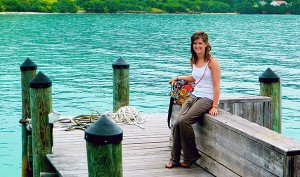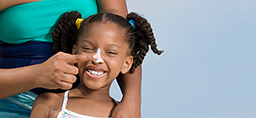
She shudders when she imagines what might have happened if she’d ignored the itchy mole on her back.
“In your 20s, you feel like nothing bad can happen. You don’t expect to get sick,” she said. “But what I’ve learned is that this can happen to anyone. Getting myself checked probably saved me.”
Now the 27-year-old hopes others can learn from her experience.
Awareness is the answer
Brummel was born with a large mole on her upper back.
She had it checked regularly by a dermatologist, and it never looked suspicious. But when that spot started itching last summer, she paid another visit to her doctor.
“I looked on the National Cancer Institute website and found that itchy or oozing moles are sometimes an indication of melanoma,” said Brummel, who earned a Master of Public Health degree in December 2014.
Her dermatologist agreed that the mole should be biopsied and removed. Three weeks later the frightening biopsy results came back.
She quickly recovered from surgeries that removed four sentinel lymph nodes and cut a wider margin of skin around the spot where the mole had been.
“Thankfully, no cancer cells were found in my sentinel lymph nodes,” she said.
As Brummel reflects on what she’s been through, she has an important message to share:
Protect yourself from the sun.
Don’t visit the tanning salon.
And don’t ignore any changes in your moles.
“We all need to be cautious,” she said. “I don’t think people realize that going to a tanning bed a few times can increase your risk, and that’s probably what led to it for me.”
Tan at your own risk
Brummel was never a sun worshiper or an avid tanner.
“I wasn’t going to the tanning salon every week,” she said. “But in high school I would go before trips to get a base tan. High schoolers and college kids, they want that tan.”
She wasn’t alone. According to 2011 research published by the Centers for Disease Control and Prevention, 21 percent of all high school girls use a tanning bed, booth or sunlamp.
“People don’t realize how dangerous tanning booths are,” said Leon Oostendorp, MD, a Spectrum Health Medical Group surgeon specializing in melanoma and breast cancer.
The World Health Organization has declared tanning beds to be carcinogenic, and the CDC calls them “particularly dangerous for younger users.”
Get a screening
Talk to your doctor or dermatologist about getting a skin cancer screening.
“The vast majority of cancers found at the screenings will be regular skin cancers, not melanoma,” Dr. Oostendorp said.
But if a case of melanoma is found, patients could be referred to the melanoma multispecialty team at the Spectrum Health Lemmen-Holton Cancer Pavilion.
This is the group Brummel relied on for guidance and treatment after receiving her diagnosis. Several melanoma team members—including an oncologist, a surgeon, a dermatologist, and a nurse navigator—met with her during a single visit to devise the best treatment plan. She was glad to have her mother and husband along for support.
“It was overwhelming and emotional, because I had just been diagnosed that week, but I loved that they were all working together on my case and that I could meet with them all on the same day.”
As she enters her first summer post-melanoma, Brummel said she’ll be wearing sunscreen, protective clothing and hats from now on—and encouraging others to do the same.
“I’m trying to make the best of a bad situation. It’s still an emotional roller coaster for me, but with my background in public health, I have a great platform for educating individuals about how to protect themselves.”

 /a>
/a>
 /a>
/a>
 /a>
/a>
vitamin d tests should be required at annual physicals, especially in children on whom is slathered gobs of sunscreen. The sun is the source of life, but like water, too much can be deadly.